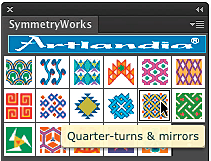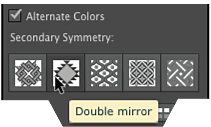We refer to the patterns by the notation of Belov and Tarkhova, with a prime (') after a symbol indicating a color reversal; as well as by H.S.M. Coxeter's "type/subtype" notation; both as described in the excellent book by Washburn and Crowe, see the references below. The type here refers to one of the 17 main symmetries, which produce patterns in a color-blind fashion (possibly with color reversals), while the subtype indicates the secondary symmetry, which is a member of the same group of 17 symmetries, but describes a part of the pattern without color reversals—that is, in the original colors or the reversed colors, alone, and on a bigger scale. The type/subtype notation is adopted in SymmetryWorks too.
We will further assume that you are familiar with the basic techniques of constructing counterchange patterns. For a refresher, please see these video tutorials.
You can find all the patterns from this tutorial in the attached PDF file. Open the file in Illustrator to experiment with the patterns.
 To see how a pattern is constructed, select any element of the pattern and take a look at the SymmetryWorks panel. The active button in the main symmetry section of the panel indicates the "type" of the pattern and the active button in the secondary symmetry section indicates the "subtype." Hover your mouse cursor over the selected buttons to read off the corresponding symmetry type and subtype.
To see how a pattern is constructed, select any element of the pattern and take a look at the SymmetryWorks panel. The active button in the main symmetry section of the panel indicates the "type" of the pattern and the active button in the secondary symmetry section indicates the "subtype." Hover your mouse cursor over the selected buttons to read off the corresponding symmetry type and subtype.



 By default, SymmetryWorks shows "long" (descriptive) symmetry names in tooltips. You can switch to the mathematical shorthand notation in the SymmetryWorks panel menu.
By default, SymmetryWorks shows "long" (descriptive) symmetry names in tooltips. You can switch to the mathematical shorthand notation in the SymmetryWorks panel menu.

 Experimenting with these classic patterns is great fun and will help you deepen your grasp of two-color symmetries. For instance, in this pgg/p2 pattern, which is constructed from a black triangle on a white background rectangle, we have changed the triangle into a polygon and assigned a gradient fill to the background, while keeping the control path (the third selected path in the image on the left) unchanged.
Experimenting with these classic patterns is great fun and will help you deepen your grasp of two-color symmetries. For instance, in this pgg/p2 pattern, which is constructed from a black triangle on a white background rectangle, we have changed the triangle into a polygon and assigned a gradient fill to the background, while keeping the control path (the third selected path in the image on the left) unchanged.

![]()

![]()

 You can also easily get your hands on the seed (motif) of every pattern in this tutorial (as in any other SymmetryWorks pattern). Simply select any part of the pattern and click the Release button.
You can also easily get your hands on the seed (motif) of every pattern in this tutorial (as in any other SymmetryWorks pattern). Simply select any part of the pattern and click the Release button.

![]()

![]()

 To get your pattern back, choose Edit > Undo Release or, if you want to re-make your pattern after some other operations, select the entire seed and Option-click the Make button (on Mac OS) or Alt-click the Make button (on Windows).
To get your pattern back, choose Edit > Undo Release or, if you want to re-make your pattern after some other operations, select the entire seed and Option-click the Make button (on Mac OS) or Alt-click the Make button (on Windows).
With these preliminaries out of the way, here is a reproduction of the Woods' counterchange patterns, arranged by the main symmetry type:




.png)

.png)






































